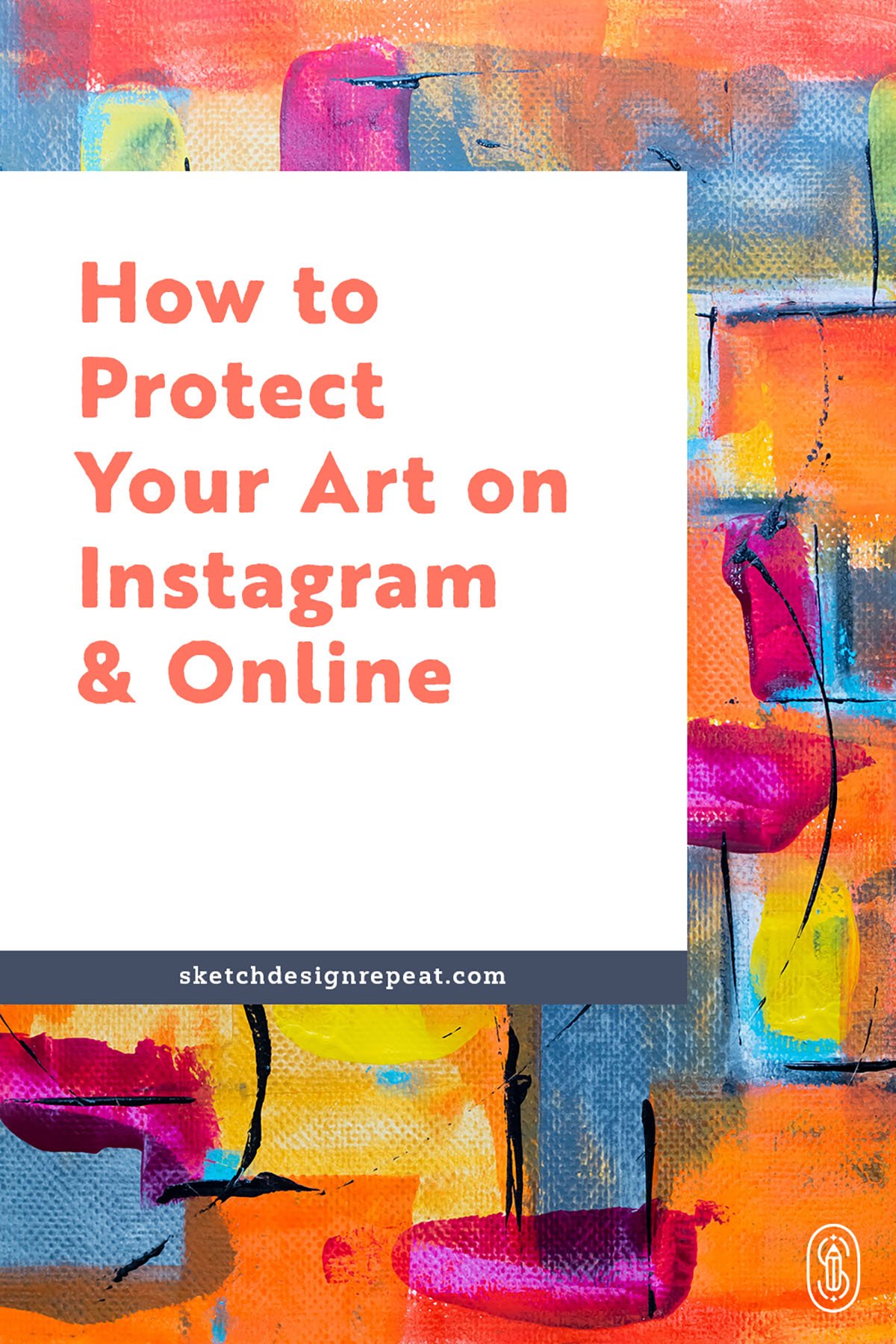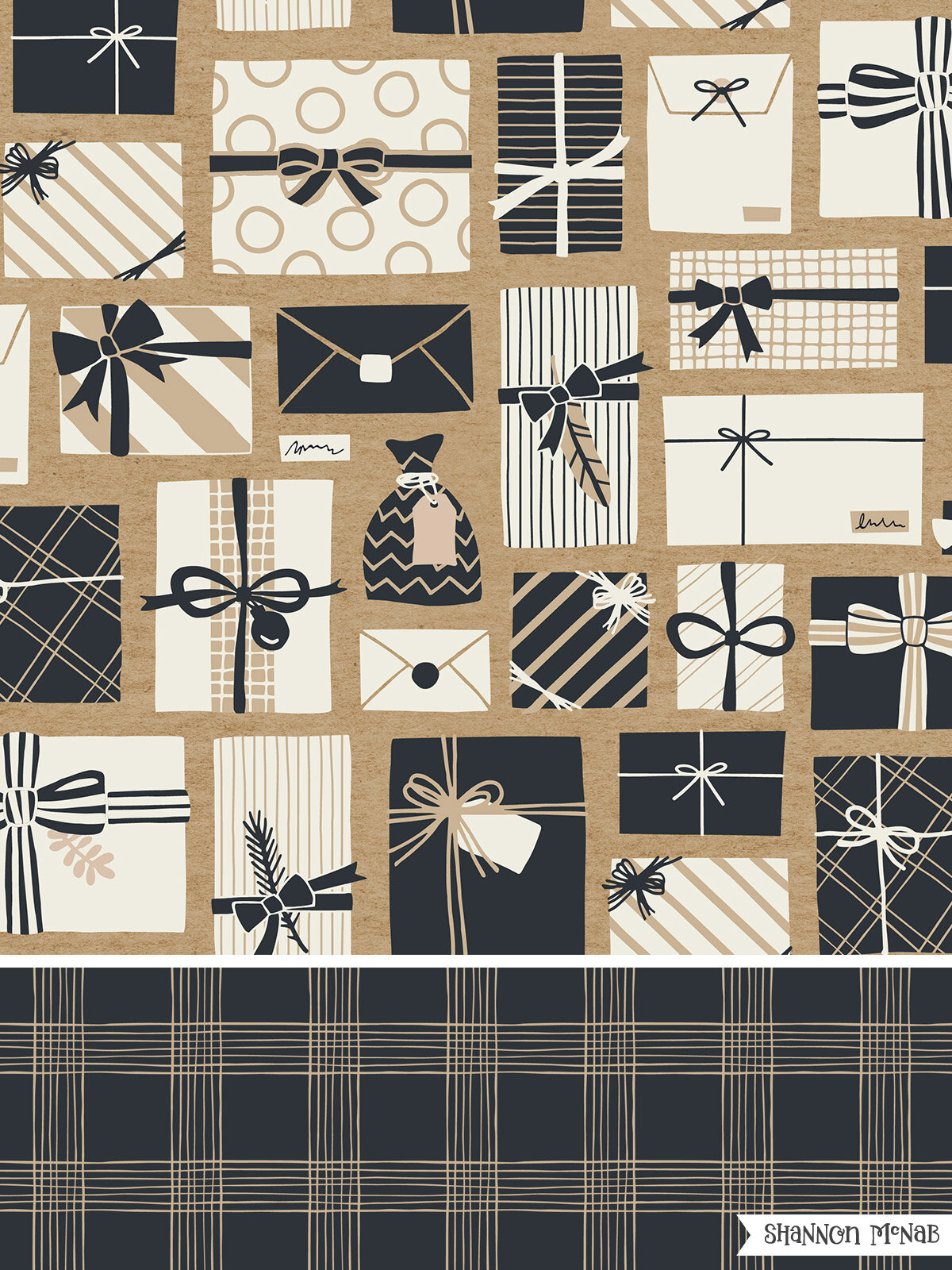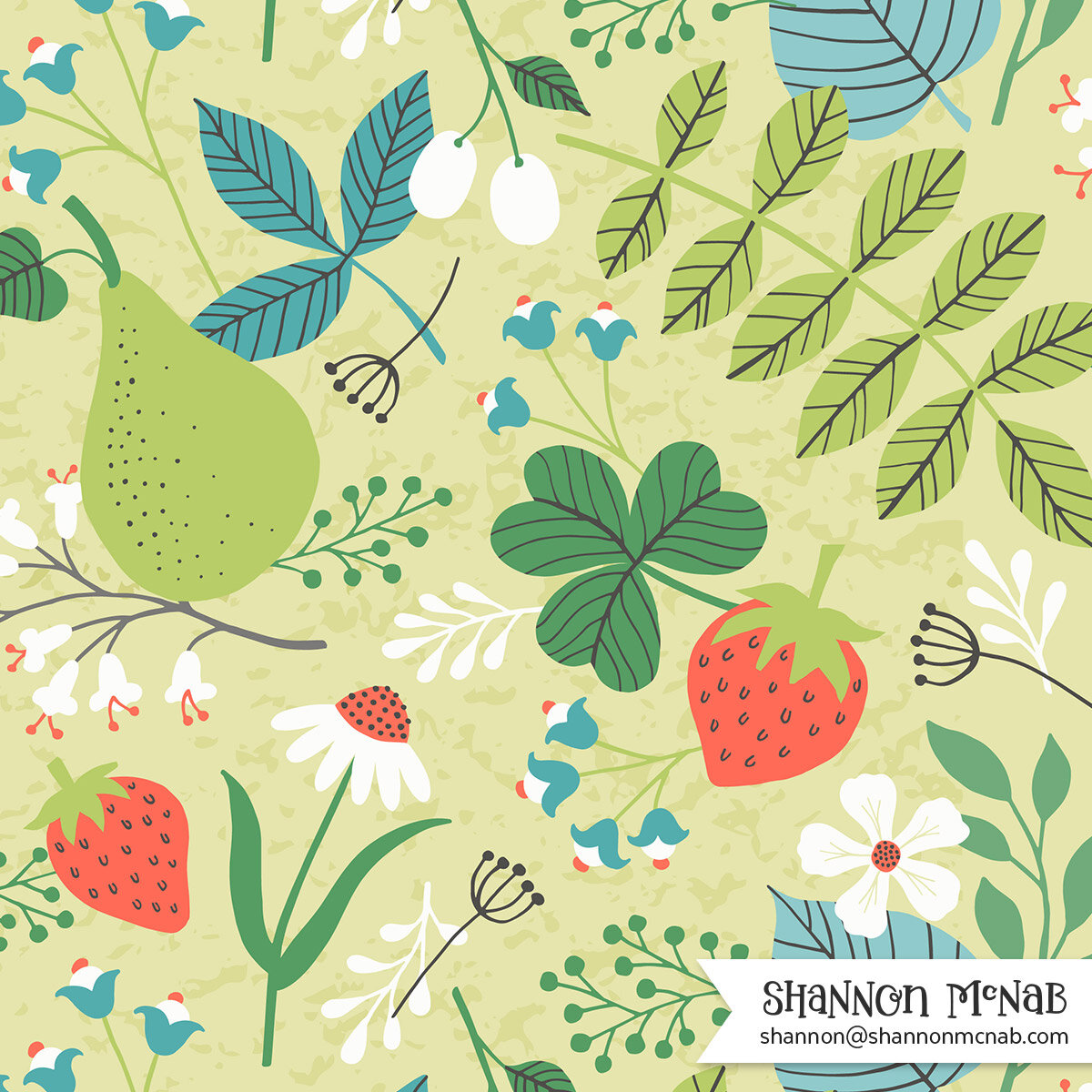For most surface designers, building or maintaining a website and continually marketing ourselves are not fun aspects of our job and yet, we know they’re important. But have you considered how your online presence is affecting your business AND how it could be negatively impacted if you’re doing the wrong things?
I’ve seen my fair share of websites in years of one-on-one consultations helping surface designers. In most cases, their websites are lovely, yet they make some pretty big mistakes that could derail their efforts to get their art licensed or even worse, make it easier for someone to steal their work.

So to make sure you don’t fall victim to the very same issues, I’ve rounded up my 5 tops tips for promoting and protecting your artwork online to help address the most common errors I see designers making with their websites.
1. Add your name or logo to every image
I know that going through the extra step to add your name on each image when saving out art for your website or Instagram may seem time consuming and trivial, but it’s ABSOLUTELY essential!
And there are some obvious advantages to having your name on a design when someone does steal or repost the image without permission, but that’s not the main reason you should do it.
The BEST reason to include your name is so you can easily be found if an art director notices your design on Pinterest.
Because whether you realize it or not, a LOT of our art ends up there!
Take the piece below as an example – it’s a design I sold to Papyrus for their 2020 Christmas gift wrap assortment. And guess what? The art director discovered my design on Pinterest.
What do you think would have happened if I hadn’t included my name? Unless the image in Pinterest linked directly to my website (which is possible, but is never 100% foolproof), the art director would have had no idea how to find me and I would have most likely lost out on a sale AND a new client.

But you do need to be strategic about how you include your name or logo. The key is to make it small enough that it doesn’t cover too much of the design, but large enough that it’s easy enough to read.
I find that it works best to add it to the bottom or corner of an image. You could also include your website URL or email address, especially if you have a more complicated logo as it makes it that much easier for art directors to find you!
2. Keep your images small
Another big mistake I see artists make is uploading enormous or even full-size images of their artwork, but that’s a terrible idea! Yes, it may save you a few extra minutes from having to save a low-res version in Photoshop, but there’s 2 ways it could cost you dearly in the long run:
Reason #1: It makes your art way too easy to steal. Most companies and artists who steal artwork are lazy and so the larger your art is, the less work they have to do to make it work for them.
Reason #2: It massively slows down the load time of your website. You only have a few seconds before you’ll lose the attention of anyone viewing your website, including art directors, so if you have a bunch of large art images that take forever to load, they’re likely to get frustrated and click away.
So how big should your images be?
Your load time will be much quicker if you can manage to make all your images are under 500 kb. For portfolio designs on the public pages of your website, I’d suggest a size between 600-800 pixels wide.
And if have a private portfolio (something I highly recommend) where you have your artwork available to art directors on a password-protected page, you should probably save your image a little larger at 800-900 pixels wide.
Finally, if you use full-length banner-style images (like the one at the top of our homepage), you’ll need to save them at around 2000 pixels wide. And because this style of image is so large, I’d suggest including no more than one full-length banner image on each page (as it’s almost impossible for it to be saved at under 500 kb).
3. Make your patterns harder to copy
It’s an unfortunate fact that those who steal artwork are getting more savvy, so anything you can do to make it more difficult to use your designs, the better.
That’s why one of my favorite techniques is to never save and share a pattern for Instagram or the public section of my website that shows its full repeat (like the floral example below). Think about it: if the entire repeat isn’t visible, it’s going to be a lot harder for someone copying your work to re-create the pattern seamlessly without taking a lot of time to do it.

Of course, this isn’t always an option, especially for simpler or geometric patterns, so in those cases, I take the opposite approach and scale down the repeat so each motif is fairly small. This makes it harder to replicate and often means the person copying it would have to redraw everything.
Still, if you want to make it even more difficult to steal a pattern, you can rotate it too – this works especially well the more complicated a pattern is.
Just make sure you rotate the art using a less common rotation – that means instead of rotating at 15, 30, or 45 degrees, try an imperfect rotation like 11 or 23 degrees. Again, this will make someone who wants to copy your pattern, work a LOT harder – and most of the time it will not be worth their effort.
4. Show the type of art you want to make
When posting your art whether it’s on Instagram or directly on your website, you want to make it as easy as possible for an art director to see you as a potential artist to work with. But how do you do that?
It’s simple really – just show your best work and the designs that represent the kind of art you want to continue making. You can be a little more flexible about this on Instagram since it’s a casual platform and it’s easier to share in-progress work, but you need to be especially particular on your website.
So how do you decide what art to post and how much to share on your website? Well, I’d always say less is more! Let me illustrate my point with two different website scenarios for an artist that has 25 designs in her portfolio:
Scenario 1: The artist selects her 6 favorite designs. It features mostly patterns, but also 2 illustrated maps because she’s really interested in editorial jobs.
Scenario 2: The same artist puts all 25 designs on her website. It has her favorite patterns and the illustrated maps, but also some early pieces she’s not fond of, including a few juvenile designs even though she has no current interest in designing kids products or children’s books.
Which version do you think makes the best impression AND gives art directors a glimpse of the kind of art she’s interested in making? I think it’s pretty obvious that it’s scenario 1.
So before just chucking all your art onto your website, take some time, look through your portfolio, and then only select the designs that show the kind of work you enjoy making.
5. Try not to worry too much
If you’re a US-based artist, you might have expected my last tip would be to get all your artwork copyrighted so it’s legally protected, but I actually find the American copyright system has far too few benefits to offset its high cost – most especially because it only protects your work if a US company or person is copying it which is not that helpful given the global economy we live in today.
The truth is copyrighting your work is a complicated issue and one that I’d like to address the pros and cons of at some point, but that’s a discussion better left for another time.
What I want to talk about is the fear artists have about sharing their art.
I see many artists who are SO scared of the possibility of their work getting stolen that it keeps them from finishing their portfolio website or regularly posting art on Instagram.
But that fear does more harm than good because sharing your art publicly is essential as a surface designer in the internet age we live in, but you’ll never feel ready to do that if you have a strong fear of being copied. So I want to let you know that…
If you’re an artist, your art WILL be stolen at some point.
I’m not saying this to be negative, but to help release you a bit from that fear. Because whether you like it or not, it will happen. So you might as well let go of that fear and make use of whatever platform you do have – website, Instagram, Pinterest, etc. – and start sharing your work.
Now it may take you a little time to come around to this idea, but it’s much more helpful to you and your business to focus on all the positive things that could happen by sharing your art freely instead of giving all the attention to the bad things that might.
And this idea can be summed up beautifully by hockey legend, Wayne Gretzky:
You miss 100% of the shots you don’t take.
So you might as well operate from a place of courage and confidence and take some shots by putting yourself and your art out there. Because the results may surprise you in so many great ways!
Thanks for the great tips, Shannon!
Thanks for the advice Shannon! We need this information. You are a treasure found!
Thank you. Great tips.
You’re approach is inspiring and practical. Thanks for all the tips.
You’re approach is inspiring and practical. Thanks for all the tips.
Thank you for all the good advices and for the wonderful saying by W. Gretzky – so inspiring!!
Thank you, Shannon!! Great info!
Thank you Shanon for sharing this great info.
These definitely will help me in the future, especially with sharing the patterns on social media. I often did the mistake of sharing the full repeat, but not from now on.
Thanks for the tips Shannon. Particularly liking no3 about the imperfect rotation – might give that a try.
Great Tips, Thank you. 🙂
Thanks for sharing your tips! Super helpful. Even more of a coincidence that the Wayne Gretzky quote is hung in my living room but as Micheal Scott quoting his quote, so the irony is not lost on me. Hahaha
💯💯💯
I’m so glad I discovered you. What’s involved in getting your 1:1 input on my art? I’m hoping that’s something you do.
Hi Doreen! I’m currently only offering portfolio reviews within my signature courses, however, once I have a little extra availability I do plan on opening up a few weeks of coaching spots. You can sign up to be notified for that right here: https://airtable.com/shr76KGpQ1XymXtl4
Yes I’m so glad I discovered you also! In my innocence of this, new to me, world of art and design, I never realised people stole others work in this sense. That’s so sad. Yet of course I guess so as there are so many lazy, unethical and selfish people in the world sadly. I knew physical artwork had always been stolen or copied but not this. I don’t think a common burglar will like my work, so no worries there! But thank you for your ideas to keep things safe here. The thieves should read Austin Kleon’s book Steal Like an Artist.
This article makes me feel like embedding tiny messages in my work that once expanded for copying would be inerasable and certainly not be every welcoming, shall we say, or perhaps the work would disappear in an instant! One day we will all be able to easily blockchain our work and samples perhaps.
Thank you for these tips and the encouragement, Shannon!
Hi Shannon, thank you very much for all the information you share! It’s reallu helpfull and inspiring.
What happen if you upload products to Pod platforms such as reddbubble or society6? Do you also recommend to add your logo or signature on them?
Tha k you once again for all!
Eugenia
It really all about balancing being protective of your work while not being too precious with it. And it’s up to you whether you’d like to include your logo or signature on designs for POD sites, but it might make it harder for you to sell products if the logo is prominently displayed.
Thank you for writing this amazing advice! A ridiculous amount of years living in fear vs sharing my art with the world. This will most definitely help my journey to reverse what has held me back in my professional life.
Thank you for the useful article!!! How would one find out that their art got stolen?
Unfortunately, most of the time you won’t know your art has been stolen. That’s why it’s so important to take simple precautions like the ideas mentioned in this post to make it harder for your art to be stolen in the first place.
Thank you for your suggestions in the article. I feel very disturbing about ppl stealing works from creator to get a job (which i had someone came to me talked to me like it is nothing wrong that she did used someone’s work for interview and told me this is so common, everyone is doing it). Also, I had bad experiences with this that I found my work got stolen in my work place so I had been in great fear of sharing creative works freely, because I feel like my efforts are for nothing.
I am still on the tough road of confronting this.
I absolutely understand the fear of sharing, especially when you’ve already been affected by someone stealing your art. And I think it’s all about balance – sharing some art (as doing so can lead to good things like getting noticed by a company), but then also keeping some of your work just to show clients.
Prepare different portfolios for social media and clients is practical and inspiring. I will keep your suggestions in mind and find ways to make it, big thank you.
(Lucky I am brave to vent, so that I have chance to see your comment ^-^)